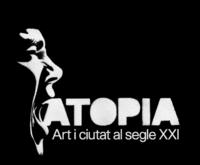ATOPIA: Art and City in the 21st Century
Atopia is the feeling of unease experienced by the individual faced with a city that does exist, but which in no case represents the paradise dreamt-of or promised, for the simple reason that the monster that is now the city has taken on a life of its own.
The exhibition ÔÇ£AtopiaÔÇØ is not one of the recent projects to be based on the social phenomenon, nor is it one of the increasing number of projects to denounce issues such as urban speculation or gentrification in cities. It focuses instead on a more universal and also more palpable agony: that of the individual who survives and what might be termed his existential resistance to the urban apotheosis.
Without prior judgment or prejudice, and always by means of artistic discourses, ÔÇ£AtopiaÔÇØ explores the city that is relinquishing its former functionsÔÇöthe functions of modern lifeÔÇöand starting to be something else. A kind of Moby Dick that breaks away from past representations and belonging to situate itself in a subsequent dimension.
The city as a space of congregation and work has given way to the city as a place of atomization and leisure (or unemployment); the space which until very recently functioned as a fantasy of encounter and realization is being transformed before our eyes into a place of loss and failure; the concrete cityÔÇöParis, Rome, Berlin, ChicagoÔÇöis losing its sharp outline and giving way to the abstract city. At the same time, Utopian citiesÔÇöthose of More and Erasmus, Bacon and CampanellaÔÇöno longer serve as a basis for the urbanization of the global city, because the latter has set itself up beyond the horizon of the things we dream of, where it floats like a freestanding platform, tracing the drift of its own wreckage.

Recommended for you
Atopia is the feeling of unease experienced by the individual faced with a city that does exist, but which in no case represents the paradise dreamt-of or promised, for the simple reason that the monster that is now the city has taken on a life of its own.
The exhibition ÔÇ£AtopiaÔÇØ is not one of the recent projects to be based on the social phenomenon, nor is it one of the increasing number of projects to denounce issues such as urban speculation or gentrification in cities. It focuses instead on a more universal and also more palpable agony: that of the individual who survives and what might be termed his existential resistance to the urban apotheosis.
Without prior judgment or prejudice, and always by means of artistic discourses, ÔÇ£AtopiaÔÇØ explores the city that is relinquishing its former functionsÔÇöthe functions of modern lifeÔÇöand starting to be something else. A kind of Moby Dick that breaks away from past representations and belonging to situate itself in a subsequent dimension.
The city as a space of congregation and work has given way to the city as a place of atomization and leisure (or unemployment); the space which until very recently functioned as a fantasy of encounter and realization is being transformed before our eyes into a place of loss and failure; the concrete cityÔÇöParis, Rome, Berlin, ChicagoÔÇöis losing its sharp outline and giving way to the abstract city. At the same time, Utopian citiesÔÇöthose of More and Erasmus, Bacon and CampanellaÔÇöno longer serve as a basis for the urbanization of the global city, because the latter has set itself up beyond the horizon of the things we dream of, where it floats like a freestanding platform, tracing the drift of its own wreckage.
Artists on show
- Adrian Paci
- Akos Birkas
- Andreas Gursky
- Baltazar Torres
- Carey Young
- Carlos Garaicoa
- Carlos Irijalba
- Dana Schutz
- Daniel Canogar
- David LaChapelle
- Dionisio González
- Douglas Gordon
- Enrique Marty
- Erwin Olaf
- Erwin Wurm
- Evan Penny
- Florin Tudor
- Gino Rubert
- Hicham Benohoud
- James Casebere
- Mona Vatamanu
- Nuno Cera
- Oleg Dou
- Philip-Lorca diCorcia
- Rafael Lozano-Hemmer
- Rogelio López Cuenca
- Sergio Belinchón
- Thomas Ruff
- Tiffany Chung
- Tim Eitel
- Vanessa Beecroft
- Vivek Vilasini

 ARTISTS
ARTISTS













